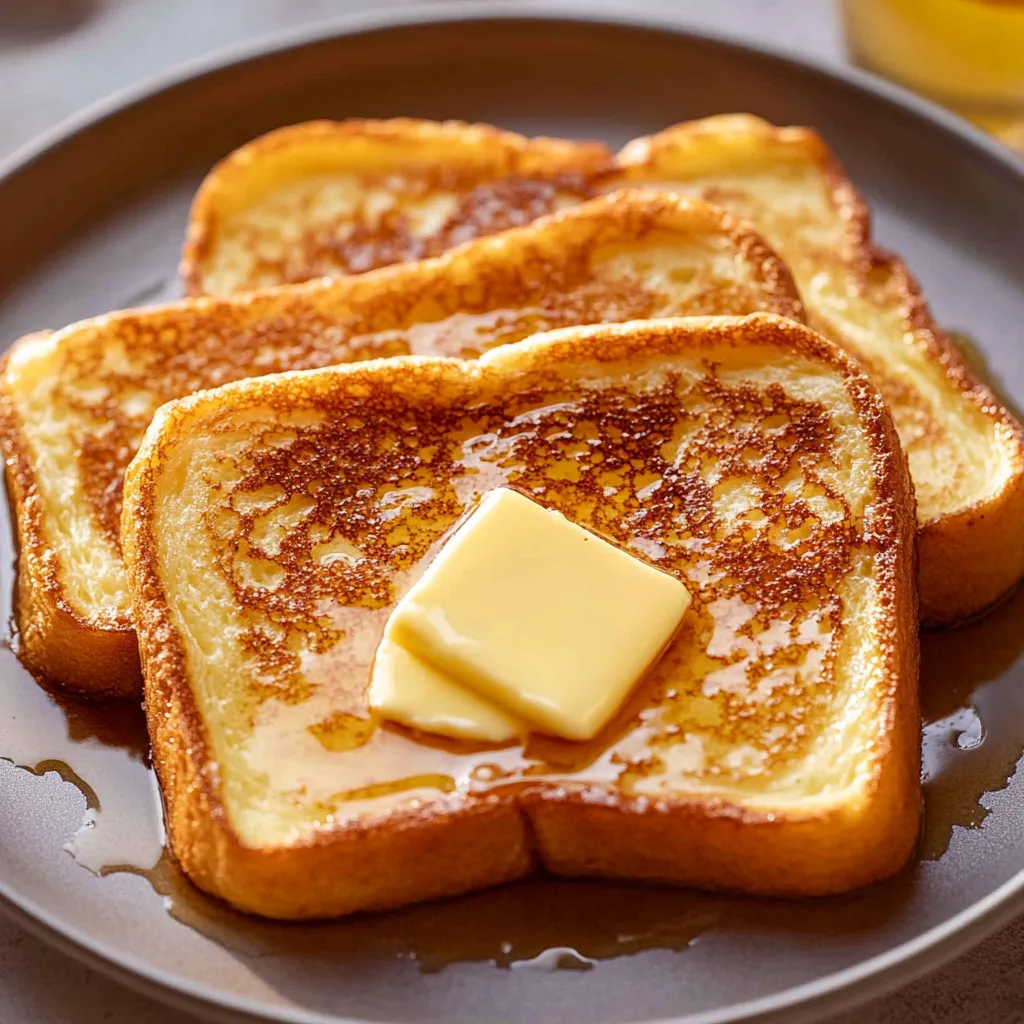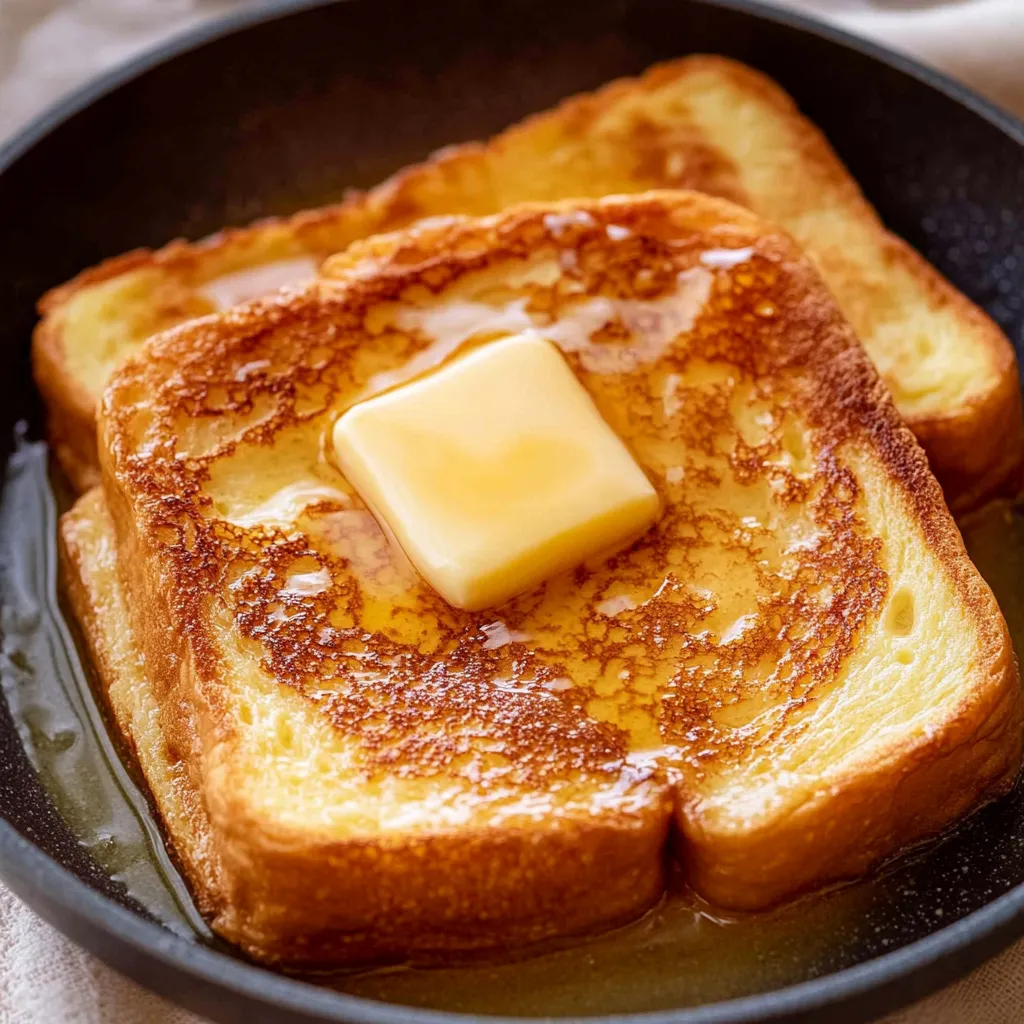 Pin it
Pin it
This classic French toast recipe transforms ordinary bread into an indulgent breakfast that's crispy and golden on the outside while remaining custardy and tender inside. The rich vanilla-cinnamon custard base soaks just enough into thick slices of bread to create that perfect texture without making them soggy or falling apart. With its simple technique and incredible flavor, this French toast elevates weekend mornings into something special that feels like a treat from your favorite brunch spot.
I grew up thinking French toast was just okay until I learned the proper technique for making it from scratch. The difference between this homemade version and the flat, soggy versions I'd had before is absolutely incredible. The key is that rich custard base and using thick slices of good bread that can absorb the mixture without falling apart. Now it's become our family's favorite weekend breakfast, and I love how the kitchen fills with the amazing smell of vanilla and cinnamon. My kids request it for special occasions, and it's become one of those recipes that makes ordinary mornings feel celebratory.
Essential Ingredients and Selection Tips:
- Fresh eggs: Use large, fresh eggs at room temperature for the smoothest custard base
- Whole milk: The fat content is crucial for richness; avoid skim milk which creates thin, watery custard
- High-quality vanilla extract: Use real vanilla extract rather than imitation for the best flavor
- Thick-sliced bread: Choose brioche, challah, or thick white bread that can absorb custard without falling apart
- Fresh ground cinnamon: Replace old, stale cinnamon with fresh for the most aromatic flavor
- Unsalted butter: For cooking and serving; controls salt content while adding rich flavor
Step-by-Step Instructions:
- Create the perfect custard base:
- In a large, shallow bowl, whisk together the eggs until smooth and well-beaten. Add the whole milk, granulated sugar, vanilla extract, ground cinnamon, and a pinch of salt, whisking vigorously until the mixture is completely smooth and pale yellow in color. The sugar should be completely dissolved, and the custard should have no streaks of egg white remaining. This rich custard is what transforms ordinary bread into luxurious French toast.
- Prepare bread for optimal absorption:
- Cut your bread into thick slices, approximately 3/4 to 1 inch thick, which provides the perfect balance between custard absorption and structural integrity. If using pre-sliced bread, choose the thickest option available. Arrange the slices on a large plate or cutting board near your custard mixture and cooking area for efficient assembly.
- Heat pan to ideal temperature:
- Place a large skillet or griddle over medium heat and add a generous pat of butter, allowing it to melt and coat the entire cooking surface. The butter should sizzle gently but not brown or smoke, indicating the perfect temperature for even cooking. Medium heat ensures the French toast cooks through evenly without burning the exterior before the interior is properly heated.
- Master the soaking technique:
- Working with one slice at a time, dip the bread into the custard mixture, allowing each side to soak for 3-5 seconds. The bread should absorb the custard but not become so saturated that it falls apart. Gently lift the slice and allow excess custard to drip back into the bowl before transferring to the hot pan. This technique ensures even coating without oversaturation.
- Cook to golden perfection:
- Place the soaked bread slice in the hot, buttered pan and cook for 2-3 minutes on the first side, until the bottom is golden brown and crispy. Don't move the bread during cooking as this prevents proper browning and crisping. You'll know it's ready to flip when the edges look set and the bottom has developed that beautiful golden color.
- Execute the perfect flip:
- Using a thin spatula, carefully flip the French toast to reveal the golden-brown first side. Cook the second side for another 2-3 minutes until equally golden and crispy. The French toast should feel set when gently pressed and have developed a beautiful caramelized exterior on both sides while maintaining a tender, custardy interior.
- Maintain optimal serving temperature:
- Transfer finished slices to a wire rack placed over a baking sheet in a 200°F oven to keep warm while you cook the remaining pieces. This method maintains crispiness while keeping the French toast at the perfect serving temperature. Add more butter to the pan between batches as needed to prevent sticking and maintain flavor.
- Serve immediately for best experience:
- Serve the French toast warm with your choice of toppings such as powdered sugar, maple syrup, fresh berries, or butter. The contrast between the crispy exterior and tender interior is best enjoyed immediately while the French toast maintains its optimal texture and temperature.
 Pin it
Pin it
The ingredient I'm most passionate about in this recipe is definitely the high-quality vanilla extract. I used to use whatever vanilla I had on hand until I invested in real vanilla extract, and the difference is absolutely remarkable. Good vanilla adds this incredible depth and warmth that makes the entire French toast taste more luxurious and aromatic. When you're making something as simple as French toast, every ingredient matters, and vanilla is what transforms the basic custard into something that smells and tastes amazing. Now I always use the best vanilla I can find because it's such a small investment that makes such a huge difference in the final result.
Custard Base Chemistry and Technique
The success of perfect French toast lies in understanding how the custard base works to transform ordinary bread. The eggs provide protein structure that sets during cooking, while the milk adds richness and helps create the creamy interior texture. The sugar not only sweetens but also aids in caramelization, creating that beautiful golden exterior. Proper whisking ensures all ingredients are fully incorporated, preventing streaky or uneven results.
Bread Selection and Preparation Mastery
Different types of bread absorb custard differently and produce varying textures in the finished French toast. Brioche and challah, with their rich, eggy composition, create the most luxurious results, while standard white bread works well for everyday preparation. The thickness of slices is crucial - too thin and they become soggy, too thick and they don't cook through properly. Day-old bread actually works better than fresh because it's slightly drier and absorbs custard more effectively.
Heat Management and Cooking Technique
Achieving the perfect balance of crispy exterior and custardy interior requires precise heat control throughout the cooking process. Medium heat allows the bread to cook evenly from outside to inside, while higher heat would burn the exterior before the interior sets properly. The butter serves multiple purposes - adding flavor, preventing sticking, and contributing to the golden-brown color through the Maillard reaction.
Timing and Workflow Optimization
Efficient French toast preparation involves organizing your workflow to maintain optimal temperature and texture. Having all ingredients ready and the pan properly heated before starting ensures smooth cooking without delays that could affect quality. Understanding how to keep finished pieces warm without losing crispiness allows you to serve everyone hot, perfect French toast simultaneously.
Topping Strategies and Flavor Combinations
The beauty of French toast lies in its versatility as a base for both simple and elaborate presentations. Classic combinations like butter and maple syrup never go out of style, while fresh fruit, nuts, and specialty syrups create more sophisticated presentations. Understanding which toppings complement rather than compete with the vanilla-cinnamon base helps create harmonious flavor profiles.
Make-Ahead and Storage Solutions
French toast can be partially prepared ahead for easier morning execution, and leftovers store and reheat beautifully when handled properly. The custard mixture can be prepared the night before, and finished French toast freezes well for future quick breakfasts. Proper reheating techniques restore much of the original texture and flavor.
This French toast recipe has become one of my most treasured weekend traditions because it transforms simple ingredients into something that feels truly special and indulgent. There's something magical about the way the custard-soaked bread sizzles in the butter and fills the kitchen with those incredible aromas of vanilla and cinnamon. Every time I make it, whether for a quiet family breakfast or when we have guests, it creates this warm, welcoming atmosphere that makes everyone want to linger around the table. It's proof that some of the best comfort foods are the ones that take everyday ingredients and treat them with care and attention to create something memorable and delicious.
Frequently Asked Questions
- → What bread works best for French toast?
- Thick-cut bread like brioche, challah, or Texas toast works perfectly. Avoid thin slices as they get soggy and fall apart.
- → Can I make French toast ahead of time?
- French toast is best served fresh and hot. You can prep the egg mixture the night before, but cook the toast right before serving.
- → Why is my French toast soggy?
- Don't soak the bread too long in the egg mixture. Just a quick dip on each side is enough. Also use medium heat, not high.
- → How do I keep French toast warm while cooking batches?
- Place cooked slices on a baking sheet in a 200°F oven to keep them warm and crispy while you finish cooking the rest.
- → What can I serve with French toast?
- Classic toppings include maple syrup, butter, powdered sugar, fresh berries, whipped cream, or a sprinkle of cinnamon.
